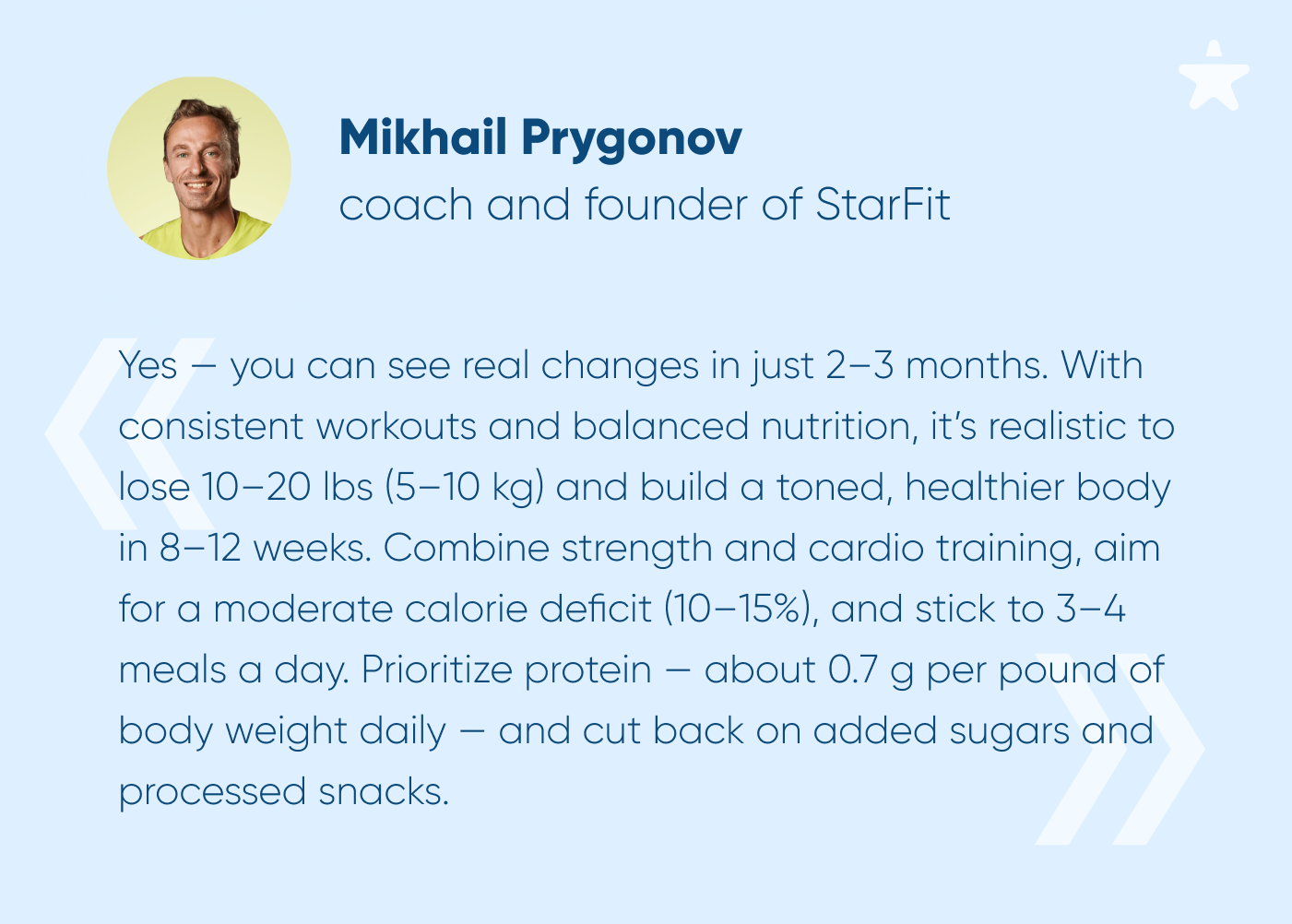{{ banner_block|raw }}
What will you get from the first training session?
From the first training sessions you will definitely get feel-good endorphins, and this is also a great result. For everything else, time will be needed.

How much time does it take? There’s no one-size-fits-all answer. We’re all unique — with different genetics, body types, and starting fitness levels. Our bodies respond to training at different speeds, so results vary from person to person. But if we look at the “average scenario,” here’s what you can generally expect.
{{ post_23|raw }}
Week 2–3: You’re on your way — here’s what’s happening inside your body
There are almost no visible changes — is it time to give up? This is exactly the point where many people quit — but that’s a big mistake. You’re closer than you think! Your body is already changing, even if you can’t see it yet. Progress is happening beneath the surface, and your training is absolutely working.
{{ post_7|raw }}
- Your heart — the body’s most important muscle — is already getting stronger. It now pumps more blood with each beat, and your resting heart rate is starting to drop.
- Blood pressure is gradually normalizing, which is especially important if yours tends to run high. Regular exercise can reduce both systolic and diastolic pressure by an average of 7 and 6 mm Hg, respectively. That might not sound like much, but even a 5-point drop can lower your risk of stroke-related death by 14%.
- Your VO₂ max — your body’s maximum oxygen uptake — is also improving. This is a key marker of overall fitness. With better oxygen delivery, your muscles can work harder, longer, and with less effort.
These are all internal changes — but what about the outside? Let’s be honest, you’re probably looking forward to the moment you catch your reflection in the mirror and think, “It’s happening! My fitness journey is finally showing!”
If your goal is to gain muscle mass
Be patient, realize that muscle mass does not increase significantly in just a couple of weeks and body fat does not dissolve as quickly as you would like.

If your goal is to lose weight
In the first week, if you train consistently (3–4 sessions), you may lose around 2.2 lbs (1 kg). By the end of the second week, weight loss tends to slow down — expect around 1 lb (0.5 kg), which is a healthy and sustainable rate of fat loss.
Think that’s not enough? Remember: real, lasting transformation takes time. If your goal is a healthy, strong, and lean body — not just for summer, but for life — you will get there with consistent training and smart habits.
Week 3 is a game-changer: why you shouldn’t quit now. This is when your body starts adapting, and you begin to build skills in your chosen workout style. Training starts to feel more natural — and begins to form into real, sustainable habits.
Now’s the time to be patient and stay consistent. Your body is rebuilding and adjusting — give it time, and the results will come.
{{ post_5|raw }}
You have completed 7–8 weeks of fitness training
You already notice that your body has transformed. Muscle relief has emerged, your figure has become more toned.
Muscle mass gain
Women who train consistently and follow a well-structured program can gain about 0.6–0.8 lbs (300–350 g) of muscle per month.
For men, thanks to higher testosterone levels, muscle gain is typically faster — about 0.4 lbs (200 g) per week, or around 1.7 lbs (800 g) per month on average.
Weight loss
The weight loss process continues. But sometimes the weight may stop or even increase. Don't worry and don't give up. This happens because the fat tissue is leaving and is being replaced by heavier tissue — muscle. In addition, weight loss is a non-linear process, weight is subject to physiological fluctuations. Therefore, regularly measure your body volumes and track their changes. This way you will know for sure that your training is producing results — the volumes are decreasing, which means everything is going according to plan.
After 12 weeks of exercising
The results of your efforts are already clearly visible. After months of consistent training, your body is noticeably leaner and more toned. You're now burning fat instead of storing it — because strong, active muscles require more energy, even when you're at rest.
You’re fueling your body with the right foods, and regular physical activity is keeping your muscles — and your whole body — in great shape.
Looking for healthy recipes? Don’t miss our helpful collection — simple, tasty, and good for you! 💚
Continue your fitness training
Now your task is to continue training, periodically changing types of fitness so that the body does not get used to constant loads. From Pilates to strength training, from cardio to stretching. Do not quit training under any circumstances, you’ll quickly lose progress if you stop. The body will instantly rebuild and switch to economy mode. Relaxed muscles will stop burning energy, and calories will be deposited as fat.

When is the best time to start exercising?
Right now! While you’re putting off your workouts, your body could already be changing — day by day, week by week — and transforming in just 10–12 weeks.
Forget “starting Monday” — your transformation starts today. There’s no better time than now.

Yes — you can see real changes in just 2–3 months. With consistent workouts and balanced nutrition, it’s realistic to lose 10–20 lbs (5–10 kg) and build a toned, healthier body in 8–12 weeks. Combine strength and cardio training, aim for a moderate calorie deficit (10–15%), and stick to 3–4 meals a day. Prioritize protein — about 0.7 g per pound of body weight daily — and cut back on added sugars and processed snacks.


















